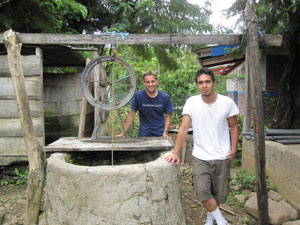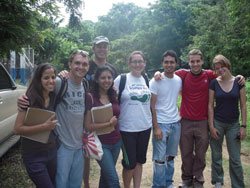UH group to put problem-solving skills to test with project abroad
About an hour drive from the Nicaraguan capital of Managua, down a dusty path winding through miles of undeveloped countryside, rests the village of Telpochapa.
Here less than a quarter of the 42 quaint, wood plank huts have their own bathroom facilities and fresh water means a trip to one of the only community wells still left in working order.
Just steps from where villagers’ cattle graze, their children attend school. Roughly constructed from sheet metal and concrete, their single room facility houses multiple grades all taught by one teacher. And although as many as 20 children are ready for preschool, lack of space allows less than half to attend class, which in recent years has been forced onto a neighbor’s porch.
Though riddled with imperfections, the picture—at least through the eyes of members of the University of Houston Chapter of Engineers Without Borders (EWB)—shows promise.
Amidst the beginnings of a new semester, these Cullen College of Engineering students are already thinking up ways to carry out the mission of this non-profit organization, which is dedicated to improving the quality of life in communities across the world through sustainable engineering projects.
“Our plan is to provide these people with those basic things we take for granted,” said Rhys Forgie, a senior chemical engineering major and co-project leader with the UH chapter. “We hope to help them build a preschool to accommodate all the children in the village as well as work with them on other projects later that improve the way they live.”
Construction of the preschool in Telpochapa would be the first project outside of Houston for the group of roughly 20, and the prospect has them excited.
“Our generation needs a more worldly outlook on things, and as engineers we can literally use our skills and apply them to different situations that will improve someone’s life,” said senior chemical engineering major and UH chapter president Christina Dang. “It’s really amazing to finally be able to do it. We’ve been waiting a long time for this.”
Establishing Roots
Through Dang’s efforts three years ago, the UH chapter of EWB got its start. Since then, projects abroad have been slow to get off the ground for the group—two separate projects in Mexico have fallen through.
But despite these setbacks, the chapter has worked hard locally to raise awareness about EWB’s dedication to bringing better infrastructure, electricity, sanitation and water access to rural communities through sustainable engineering projects.
There have been outreach projects at Houston area schools teaching middle and high school students about water quality through the organization’s homemade water desalination station as well as instruction on how to build solar ovens out of pizza boxes. In addition, the chapter has made regular appearances at UH’s Sustainability Day to share knowledge about clean water. And for the last two years, they have held their annual Real Football tournament, a barefoot soccer competition that takes place each spring to raise money to fund their efforts.
All this, Dang said, has helped them prepare for this opportunity in Nicaragua.
“The things we have been doing are not only helping kids and helping educate the community, but helping us prepare,” Dang said. “These projects help us do something that creates a team atmosphere and teaches us how to communicate with large groups while in country.”
The group plans to make a March trip back to the Central American country. Here, they will work with the villagers to collect the information necessary to develop a more detailed plan for erecting the preschool.
It’s a mission they started last August when Forgie and fellow UH member and senior mechanical engineering major Eric Bustamante visited parts of Nicaragua with the Rice University chapter of the organization.
Learning by Example
For the UH group, the trip last summer was meant to be a learning experience. The chapter has worked alongside Rice’s group to hone their skills at things such as testing water quality and laying concrete in workshops since their 2006 inception. This latest mission abroad was no different.
“We had no experience with any of these trips,” Forgie said. “Rice helped us not only with how the process of EWB works, but with the customs and culture in Nicaragua, where to go, what to eat and what not to eat and how prepared we needed to be for our next trip.”
Forgie and Bustamante tagged along with Rice ontheir assessment visit of a small community called San Antonio where they got a first-hand look at exactly what will need to be done in Telpochapa later this year.
“We gathered information necessary for Rice’s project,” said Bustamante. “This included surveys of the topography and also general questions for the community members. This experience really prepared us for our assessment trip in Telpochapa by helping us realize the information we needed to gather and also allowed us to get a feel for working with a community.”
In addition to the school project, the student group also has plans to address waste management in the village.
“The limited number of latrines causes waste to seep into the soil and contaminate the wells and rivers, especially after it rains,” said Forgie. “This causes the people of the village to become sick from the consumption of the polluted water.”
Upon their return from their own assessment trip for the project, the chapter will begin designing the preschool as well as plans for waste management, both of which must be approved by a board of professional engineers from the organization’s national chapter before actual construction starts. The group is hopeful for a summer start.

